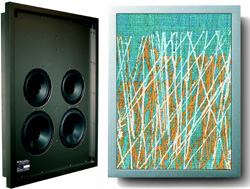For years the hang-on-the-wall TV was merely a fantasy for interior designers and homeowners frustrated by oversized TV cabinets. Now that plasma and LCD TVs have made the dream come true, TVs are finding their way into places they weren’t allowed before. This is just the beginning. Sales of flat-panel TVs skyrocketed 1,600 percent last year thanks to falling prices and a wider selection of screen sizes, and analysts expect flat-panel TV sales to continue to leapfrog 100 percent to 200 percent a year for the foreseeable future.
But the flat screen is only part of the picture. Many of the designer-friendly TVs don’t include speakers. If they do, the speakers don’t deliver the kind of impact people have come to expect from an upscale audio/video system. These days sound is as much a part of the entertainment package as image, leaving a challenge for speaker makers and interior designers alike.
Those clients were the inspiration for a new line of thin loudspeakers from Artcoustic, a U.K.-based company with roots in the designer hi-fi market. Artcoustic speakers are slim enough to mount on the wall and can have virtually any texture, color, or image applied to their blank-canvas screens. That can be a homeowner’s artwork or photography delivered as a JPEG or TIF file or an interior designer’s carefully matched fabric.
The concept of speaker grilles as artwork isn’t exactly new. Nor has it been particularly successful in the past. The products have been compromised both as art and as accurate audio products since neither reproduced the original material particularly well.
Artcoustic USA sales director John Caldwell believes the concept hasn’t succeeded previously because too much emphasis was placed on the artistic quality of the speakers. “We feel that people threw the baby out with the bathwater because they didn’t like the art you had,” he says. “If you look at our designs, it’s not Cezanne or Renoir or great masterpieces. Most of what we have has come from interior designers who did something for their clients which we then added to our portfolio. They get a commission on any design that sells.”
Now Artcoustic USA plans to ride the coattails of flat-panel TV sales success in the home and commercial markets on this side of the Atlantic.
The speakers come in eight sizes ranging from 13 by 10.6 by 2.5 inches (H x W x D) to 51 by 34.5 by 5 inches. Suggested retail prices start at $750 each for standard fabric grilles, and complete multi-speaker home theater systems begin at $4,900. Standard frame finishes are silver, black, and white; and eight standard fabrics are ivory, parchment, taupe, coffee, sky blue, pewter gray, midnight blue, and ebony. For an additional $230 to $450 per speaker, customers can select patterned designer finishes from European fabric houses Zimmer+Rohde and Sahco Hesslein.
Alternatively, customers can choose a printed image either from the Artcoustic vault or from a high-resolution JPEG or TIF image file they submit themselves. The fabrics meet acoustical specifications that don’t impede the flow of music into the room, but there’s a black scrim behind the fabric to prevent the speaker drivers from showing through if light shines on the fabric. Caldwell says the speakers and crossover networks have been engineered to accommodate for the slight attenuation that occurs as a result, a common practice in any speaker design.
Artcoustic’s mission is to design quality loudspeakers first, artistic décor panels second. The attention to sound quality, he believes, sets the line apart from other speaker-as-art products. That’s not an easy feat with speakers that measure only 5 inches deep because the laws of physics require a generous amount of airspace to reproduce the long sound-waves produced by deep bass instruments. That’s where Donvig’s speaker design background with Bang & Olufsen came into play.
Donvig designed mechanically controlled valves to manipulate the pressure in the box to boost bass response. The vents release pressure so that the woofer is “tricked” into acting as it would in a box several times the size, says Caldwell. Artcoustic claims a low-end frequency response of 20 Hz—the thumps and rumbles produced by a bass drum or pipe organ—from the 5-inch-deep subwoofer that mounts on a wall. The lower the frequency, the greater the sound vibration, so to minimize the buzz Artcoustic builds its thin drivers into a dense, rigid box. The speakers range in weight from 4.4 pounds for the 10.5-by-8.5-by-2.5-inch mini speakers to 121 pounds for the 51-by-34.4-by-5-inch DFF 130-90.
Leja says the decorative screens are sold as an adjunct to the loudspeakers. In fact, the company encourages customers to consider the fabric screens as replaceable—and upgradeable. “Typically people order a standard fabric color screen and then an additional screen, and when it’s time to redecorate they can pick out something new,” he says. The company sends out an online newsletter alerting customers to new designs.
As for the artwork in the Artcoustic gallery, Leja doesn’t try to represent the inkjet prints as high-end works of art. He prefers to emphasize the customization possibilities of the speaker grilles instead. “It’s not going to be like an inkjet print on glossy paper,” he says. “Since images are printed on fabric there’s some loss of detail. But,” he says, “the colors are very good.
—Rebecca Day specializes in writing about home electronics. She can be reached at customhomerd@aol.com.



